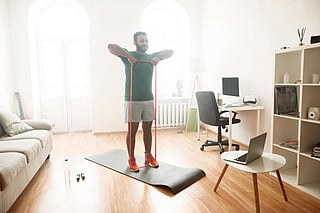Choose achievable goals.
“When starting a workout routine, most people overcommit and end up giving up. When beginning an exercise routine, start with 1-2 times a week, and see if you can maintain that for a month. If you can, then slowly increase from there, but do what works with your schedule and your existing daily routine.” — Lisa Schoenholt, owner of Brooklyn Embodied Pilates
“Set your personal goals, but make them realistic. Make movement a priority. Show up for you. Ask yourself daily, ‘how do I want to feel in my body?’” — Genny Mack, fitness coach and holistic nutritionist
Focus on behavior, not motivation.
“No one is motivated to work out all the time — even professional health experts and elite athletes. If we had to rely on wanting to work out in order to get into the gym, most of us wouldn’t be showing up consistently. Instead, build your workout time into your life in a way that’s realistic and sustainable, the same way you carve out time to eat, sleep, shower and do all your other daily non-negotiables. It’s much easier to get to the gym when it’s in your calendar for the same time every Monday and Wednesday, rather than having to wake up every day and decide whether or not you’re in the mood.” — VanHouten
Planning is better than winging it.
“The last thing you want is to show up for your workout but have zero idea what you will do. Plan your workout in advance, whether that is getting ideas from YouTube or having a personal trainer program specifically for you. Know what your workout is so you do not get overwhelmed at the time and can be confident going into your workout.” — Missy Berkowitz, NASM certified personal trainer and StrongBoard certified PT and instructor, owner of Dig Your Deepest
Set movement reminders.
“Remembering to move can be difficult during busy days stuck in front of screens, but it’s important we do, as sitting more than six hours a day is associated with increased risk of diabetes, heart disease and a higher risk of early death. A simple way to remember is setting movement reminders on your phone or computer once every 30 minutes or changing your video meetings to phone so you can walk and talk. Even if it’s a standing break, it’s better than prolonged sitting.” — Lin
Taste test workouts.
“Find what you like and what inspires you to come back. Try different classes, different instructors and even different times of the day. Figure out what time of the day you are more likely to commit to, and sample different styles and trainers to see what you gel with.” — Berkowitz
“Your body is dynamic. Your body has the ability to mobilize and stabilize to protect you. Try dancing, jogging, yoga, stretching, strength training, cardio, boxing, and meditation, for example, and find your groove.” — Mack
Ask questions, learn your body and implement workouts that work for your body type and health.
“Everything isn’t for everyone. All bodies react differently. Learn the ways of training, or hire a trainer to help you. Exercising is an investment in you that pays off heavily.” — Willie Fortune, professional boxer and founder and owner of Jabs Gym Birmingham and Jabs Gym Ferndale


